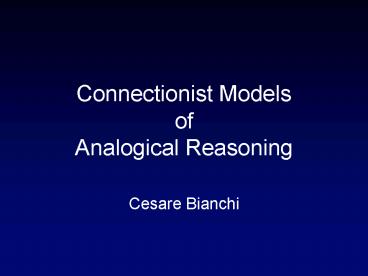Connectionist Models of Analogical Reasoning - PowerPoint PPT Presentation
1 / 25
Title:
Connectionist Models of Analogical Reasoning
Description:
Use features (instead of random patterns) in Leech's model. Try to add synchronized patterns to Leech's model ... Leech, Mareschal and Cooper, 2003. ... – PowerPoint PPT presentation
Number of Views:46
Avg rating:3.0/5.0
Title: Connectionist Models of Analogical Reasoning
1
Connectionist ModelsofAnalogical Reasoning
- Cesare Bianchi
2
Overview
- Symbolic and Connectionist Models
- The Binding Problem
- LISA Model
- Leechs Model
3
Models of Analogical Reasoning
- Symbolic
- SME
- IAM
- I-SME
- SEQL
- ACT-R
- BORIS
- MORRIS
- Hybrid
- COPYCAT
- TABLETOP
- LETTER-SPIRIT
- METACAT
- AMBR and AMBR-2
- ASTRA
- ABR-conposit
- Connectionist
- ACME
- STAR-1 and STAR-2
- DRAMA
- Analogator
(French, 2002)
4
Differences
- symbolic systems readily model structure
sensitivity but often fail to demonstrate
humanlike flexibility, whereas connectionist
systems exhibit flexibility in pattern matching
and generalization but have great difficulty in
forming or manipulating structured
representations - (Hummel and Holyoak, 1997)
5
The binding problem
- Representing a proposition entails binding the
argument roles of the proposition to their
fillers - (ibidem)
John loves Mary
Loves
John
Mary
lover
beloved
6
The binding problem
- Symbolic solution
John loves Mary
Loves
lover
beloved
John
Mary
7
The binding problem
- Connectionist solution
John loves Mary
Loves
Hates
Mary
Lucy
John
Sam
8
The binding problem
- Adding Synchronicity
Loves
Mary
John loves Mary
John
lover
beloved
9
LISA
- LISA (Learning and Inference with Schemas and
Analogies), represents propositions (predicates
and their arguments) as distributed patterns of
activation over units representing semantic
primitives. - (ibidem)
10
LISA Architecture
Structure Units
John loves Mary
P Units
John-loves1
Mary-loves2
Sub Proposition (SB) Units
loves1
loves2
John
Mary
Predicate and Object Units
Semantic Units
actor
emotion1
positive1
patient
emotion2
positive2
male
human
female
11
LISA Architecture
Firing Scheme
John loves Mary
John-loves1
Mary-loves2
loves1
loves2
John
Mary
actor
emotion1
positive1
patient
emotion2
positive2
male
human
female
12
LISA Architecture
Firing Scheme
John loves Mary
John-loves1
Mary-loves2
loves1
loves2
John
Mary
actor
emotion1
positive1
patient
emotion2
positive2
male
human
female
13
LISA Architecture
Firing Scheme
John loves Mary
John-loves1
Mary-loves2
loves1
loves2
John
Mary
actor
emotion1
positive1
patient
emotion2
positive2
male
human
female
14
LISA Architecture
likes1
Analogical Mapping
loves1
Bill
likes2
Bill likes Susan
John
Susan
loves2
fears1
John loves Mary
Peter fears Beth
Peter
Mary
fears2
Driver
Recipients
Beth
15
LISA strength
- unlike virtually all current analogy models
in which mapping is treated as an explicit
comparison between analogs (based on symbols
representing hypothesized correspondences),
mapping in LISA is a much more implicit process
in which the recipient reacts to semantic
patterns created by the driver. - (ibidem)
16
LISA limitations
- LISA has a number of inherent limitations,
including capacity limits, sensitivity to the
manner in which a problem is represented, and
sensitivity to strategic factors such as the
order in which elements of a problem are
processed. - (ibidem)
17
Leechs Model
- ... there is no explicit coding of the relation
itself. The similarity between two different
examples of a relation (e.g. the similarity
between applecut-apple and breadcutbread) lies
in how the perceptual features of the objects
involved are transformed. - (Leech et al., 2003)
18
Leechs Model
Output 1 Transformed Object
Output 2 Causal Agent
Hidden
Input 1 Object
Input 2 Causal Agent
19
Leechs Model
Training Contrastive Hebbian Learning
- Random Patterns
- 20 Objects
- 4 Causal Agents
- 4 Transformation Vectors
Transformation Vector Cutting
Output 1 Cut Apple
Output 2 Knife
Hidden
Input 1 Apple
Input 2 Knife
20
Leechs Model
Priming
Output 1 Cut Apple
Output 2 Nothing
Hidden
Input 1 Apple
Input 2 Nothing
21
Leechs Model
Priming
Output 1 Cut Apple
Output 2 Knife
Hidden
Input 1 Apple
Input 2 Knife
22
Leechs Model
Retrieval
Output 1 Nothing
Output 2 Nothing
Hidden
Input 1 Bread
Input 2 Nothing
23
Leechs Model
Retrieval
Transformation Vector Cutting
Output 1 Cut Bread
Output 2 Nothing
Hidden
Input 1 Bread
Input 2 Nothing
24
Future directions
- Use real distributed representation in LISA
model - Use features (instead of random patterns) in
Leechs model - Try to add synchronized patterns to Leechs model
- Test both models with larger knowledge base and
more complex problems
25
References
- French, 2002. "The computational modeling of
analogy-making." Trends in Cognitive Sciences.
6200-205 - Hummel and Holyoak, 1997. "Distributed
representations of structure A theory of
analogical access and mapping." Psychological
Review. 104427-466 - Leech, Mareschal and Cooper, 2003. "A
connectionist account of analogical development"
in R. Altman D. Kirsch (Eds.), Proceedings of
the twenty-fifth annual conference of the
Cognitive Science Society. 710-715. London LEA

